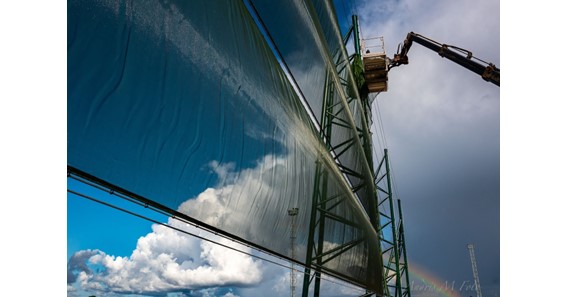Introduction
What is a Wind fence? At WeatherSolve Structures, we aim to provide our customers with the best systems suited to their needs. Due to wind, dust is transported along with spray and other pollution. Furthermore, wind also causes soil erosion. The effects of the wind vary for each location and situation.
We use wind fences to avoid any damage to a site from these factors. A wind fence is a large fabric wall that can be constructed up to 30 meters (100 ft). They can be made from several textiles, depending on the size of the site, the customer’s requirements, and their budget.
Wind fences must be set up upwind and downwind of your site to effectively reduce the wind’s speed and force by deflecting it. At WeatherSolve Structures, we also have an option for Custom Wind Fencing.
A wind fence can reduce windspeeds by more than 50% over large regions and more than 80% over smaller areas. A wind fence directs the wind to another location and slows the wind down there.
With WeatherSolve’s expert team, you can build Custom Wind Fencing, which will maximize the reduction of windspeeds, allowing protection to your inventory. The most effective windbreaks create a zone where approximately a fourth of the wind’s speed is lowered. By allowing a little wind to pass through, windbreaks reduce the amount of “crashing down and in.”
The wind passing through for a few hundred feet keeps the quicker (deflected) wind at bay. As a result, there is less turbulence, and the breezes can reunite more gradually.
Importance of Wind Fences
The next question that comes up is why wind fences are so important. Well, wind fences limit the wind crossing your worksite and allow for the least product invasion and dangerous dust clouds.
To do this, a zone is created behind the wind fence to slow the wind to about one-fourth of its natural speed. For instance, a 50-foot windbreak will increase the zone’s downwind length by around 250 feet. The wind speed will grow from 250 feet to 500 feet, reaching a maximum of nearly half that of the incoming wind. Wind speeds pick up fast after that.
Another benefit of windbreaks is their low maintenance requirements; once erected, they don’t need to be cleaned up daily or powered, and they’ll stay working continuously. Since they don’t use oil, gas, electricity, or water, they are also environmentally beneficial. And with WeatherSolve’s Custom Wind Fencing, you can get a system that suits your needs perfectly.
The main objective of controlling dust is to reduce wind speed. Additionally, wind fences can be useful in various scenarios, such as Areas for processing trash and debris, pond waves and turbulence, fences and privacy, snow control and deflection, towers for air cooling that use wind deflection, and more.
WeatherSolve’s Wind Fencing
WeatherSolve Structures are specifically created to fit your needs. As a result, your site can continue functioning as you intended it to receive a solution appropriate for your location. It is prepared for weather conditions by matching your environment (ice, snow, wind, corrosiveness, etc.) and is priced affordably and suited for the level of control you require. Since wind creates and disperses dust, slowing the wind is the primary goal of any dust control method. Typically, there are two primary causes of fugitive dust: Eroded dust and Airborne dust.
Eroded dust is when particles are blown away in this situation after being raised from the ground or the surface of a pile. The rate of the wind has a huge impact on the erosion process. By halving the speed, wind fences can reduce the dispersal of dust to 1/8th. Erosion (wind speed)3 has been demonstrated by research. This implies that a pile shedding 2000 lbs. of dust per month would lose less than 250 lbs.
Airborne dust is where dust is dispersed by machinery or dropped from a conveyor. The area impacted can be cut in half by using a wind fence to cut the wind speed in half. The best control of extremely small airborne particles requires an agent that binds particles together. The most effective and environmentally friendly way to do this is using fog. WeatherSolve Structures collaborates with top fogging system manufacturers to develop composite solutions that combine fog and Custom Wind Fencing.
With WeatherSolve Structures Custom Wind Fencing, you can limit wind erosion by bringing the wind speed on their leeward side below the threshold needed to start soil movement and by shortening the field’s length in the direction of the erosive wind.
Along with this, Wind fencing can help you reduce the wind load on sensitive inventory, such as delicate crops that are susceptible to damage from strong winds. Furthermore, Custom Wind Fencing provides you with privacy for your home as well as for sporting events. Not only this, but one of the best things about a wind fence is that it makes it easier to enclose your athletic area.
It typically stands 100 feet tall and protects against up and downwind, giving you complete control over your athletic field! It guarantees a safe, enclosed area surrounding the sporting event, preventing any disruptions to the action. Along with this, the wind fences protect your inventory by deflecting the snow. When the wind hits the barrier, it moves over the barrier. During this time, the wind loses energy and no longer retains enough to carry a snow load. This will be helpful to farmers who are tired of snow continuously ruining their crops.
Conclusion
WeatherSolve can address any site concern by providing Custom Wind Fencing thanks to its global knowledge and specialized service. As a forward-thinking business, we always relish the challenge of developing fresh approaches to find the best solution.

17 thoughts on “Wind Fence Types and Effects”
Comments are closed.